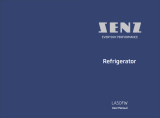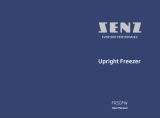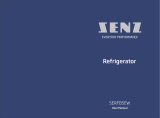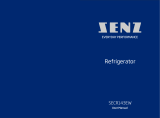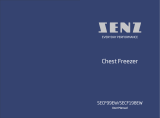Sidan laddas...

EVERYDAY PERFORMANCE
LA505FW
User Manual
Refrigerator

GB
NO
FI
DK
SE
Bruksanvisning – Svenska ..................................sida 76 - 93
NO
DK
SE
Bruksanvisning – Norsk ......................................side 22 - 39
Brugervejledning – Dansk ..................................side 58 - 75
FI
3
Käyttöopas - Suomi .............................................sivu 40 - 57
Instruction Manual – English ..............................page 4 - 21
GB
Thank you for purchasing your new SENZ Refrigerator.
These operating instructions will help you use it properly and safely. We
recommend that you spend some time reading this instruction manual in order
that you fully understand all the operational features it offers. Read all the
safety instructions carefully before use and keep this instruction manual for
future reference.
Takk for at du kjøpte ditt nye SENZ Kjøleskap.
Denne bruksanvisningen vil hjelpe deg med å bruke den på en trygg og riktig
måte. Vi anbefaler at du tar deg tid til å lese gjennom hele bruksanvisningen for
å bli fortrolig med alle funksjonene som tilbys. Les alle sikkerhetsanvisningene
nøye før bruk, og oppbevar bruksanvisningen for fremtidig referanse.
Kiitos, kun valitsit uuden SENZ jääkaapin.
Nämä käyttöohjeet opastavat sinua käyttämään laitetta oikein ja
turvallisesti. On suositeltavaa käyttää aikaa tämän käyttöoppaan
lukemiseen, jotta ymmärrät täysin, mitä toiminnallisia ominaisuuksia
tuote tarjoaa. Lue kaikki turvallisuusohjeet huolellisesti ennen laitteen
käyttöä ja säilytä käyttöopas myöhempää käyttöä varten.
Tak for købet af dit nye Køleskab SENZ.
Disse brugervejledninger hjælper dig med at bruge dette apparat rigtigt og sikkert.
Vi anbefaler, at du læser denne brugervejledning, så du får en fuld forståelse af
hvordan alle funktionerne virker. Læs sikkerhedsforskrifterne grundigt inden brug,
og gem denne brugervejledning til senere brug.
Tack för att du har köpt ditt nya SENZ Kylskåp.
Denna bruksanvisning hjälper dig att använda den på ett säkert och korrekt sätt.
Vi rekommenderar att du tar dig tid att läsa igenom denna bruksanvisning för
att till fullo förstå alla driftfunktioner som den erbjuder. Läs noga igenom alla
säkerhetsinstruktioner före användning och spara bruksanvisningen för
framtida bruk.

45
GB
1. Safety warnings
This appliance is intended to be used in household and
similar applications such as staff kitchen areas in shops,
offices and other working environments; farm houses and by
clients in hotels, motels and other residential type
environments; bed and breakfast type environments;
catering and similar nonretail applications.
This appliance is not intended for use by persons (including
children) with reduced physical, sensory or mental
capabilities, or lack of experience and knowledge, unless
they have been given supervision or instruction concerning
use of the appliance by a person responsible for their safety.
Children should be supervised to ensure that they do not
play with the appliance.
If the supply cord is damaged, it must be replaced by the
manufacturer, its service agent or similarly qualified persons
in order to avoid a hazard.
Do not store explosive substances such as aerosol cans with
a flammable propellant in this appliance.
The appliance has to be unplugged after use and before
carrying out user maintenance on the appliance.
Warning: Keep ventilation openings, in the appliance
enclosure or in the built-in structure, clear of obstruction.
Warning: Do not use mechanical devices or other means to
accelerate the defrosting process, other than those
recommended by the manufacturer
Warning: risk of fire/ flammable materials
Warning: Do not damage the refrigerant circuit.
Warning: Do not use electrical appliances inside the food
storage compartments of the appliance, unless they are of
the type recommended by the manufacturer.
Warning: Please abandon the refrigerator according to local
regulators for it use flammable blowing gas and refrigerant.
Warning: When positioning the appliance, ensure the supply
cord is not trapped or damaged.
Warning: Do not locate multiple portable socket-outlets or
portable power supplies at the rear of the appliance.
Do not use extension cords or ungrounded (two prong )
adapters.
Danger: Risk of child entrapment. Before you throw away
your old refrigerator or freezer:
- Take off the doors.
- Leave the shelves in place so that children may not easily
climb inside.
The refrigerator must be disconnected from the source of
electrical supply before attempting the installation of
accessory.
Refrigeranta and cyclopentane foaming material used for the
appliance are flammable. Therefore, when the appliance is
scrapped, it shall be kept away from any fire source and be
recovered by a special recovering company with
corresponding qualification other than be disposed by
combustion, so as to prevent damage to the environment or
any other harm.
1.1 Warning

6
7
GB
The necessity that, for doors or lids fitted with locks and
keys, the keys be kept out of the reach of children and not in
the vicinity of the refrigerating appliance, in order to prevent
children from being locked inside
For EN standard: This appliance can be used by children aged
from 8 years and above and persons with reduce physical
sensory or mental capabilities or lack of experience and
knowledge if they have been given supervision or instruction
concerning use of the appliance in a safe way and
understand the hazards involved. Children shall not play with
the appliance. Cleaning and user maintenance shall not be
made by children without supervision. Children aged from 3
to 8 years are allowed to load and unload refrigerating
appliances.
To avoid contamination of food, please respect the following
instructions:
- Opening the door for long periods can cause a significant
increase of the temperature in the compartments of the
appliance.
- Clean regularly surfaces that can come in contact with food
and accessible drainage systems.
- Clean water tanks if they have not been used for 48 h; flush
the water system connected to a water supply if water has
not been drawn for 5 days. (note 1)
- Store raw meat and fish in suitable containers in the
refrigerator, so that it is not in contact with or drip onto
other food.
- Two-star frozen-food compartments are suitable for
storing pre-frozen food, storing or making ice-cream and
making ice cubes. (note 2)
- One-, two- and three-star compartments are not suitable
for the freezing of fresh food. (note 3)
- For appliances without a 4-star compartment: this
refrigerating appliance is not suitable for freezing
foodstuffs. (note 4)
- If the refrigerating appliance is left empty for long periods,
switch off, defrost, clean, dry, and leave the door open to
prevent mould developing within the appliance.
Note 1,2,3,4: Please confirm whether it is applicable
according to your product compartment type.
For a freestanding appliance: this refrigerating appliance is
not intended to be used as a built-in appliance.
Any replacement or maintenance of the LED lamps is
intended to be made by the manufacturer, its service agent
or similar qualified person. (See chapter 2.4 for lamp
replacement)

8 9
GB
1.2 Meaning of safety warning symbols
Prohibition
symbols
Warning
symbols
Note
symbols
This is a prohibition symbol.
Any incompliance with instructions marked with this symbol may
result in damage to the product or endanger the personal safety
of the user.
This is a warning symbol.
It is required to operate in strict observance of instructions
marked with this symbol; or otherwise damage to the product or
personal injury may be caused.
This is a cautioning symbol.
Instructions marked with this symbol require special caution
Insufficient caution may result in slight or moderate injury, or
damage to the product.
This manual contains lots of important safety information which shall be
observed by the users.
1.3 Electricity related warnings
Do not pull the power cord when pulling the power plug of
the refrigerator. Please firmly grasp the plug and pull out it
from the socket directly.
To ensure safe use, do not damage the power cord or use the
power cord when it is damaged or worn.
Please use a dedicated power socket and the power socket
shall not be shared with other electrical appliances.
The power cord should be firmly contacted with the socket or
else fires might be caused.
Please ensure that the grounding electrode of the power
socket is equipped with a reliable grounding line.
Please turn off the valve of the leaking gas and then open the
doors and windows in case of leakage of gas and other
flammable gases. Do not unplug the refrigerator and other
electrical appliances considering that spark may cause a fire.
Do not use electrical appliances on the top of the appliance,
unless they are of the type recommended by the
manufacturer.
1.4 Warnings for using
Do not arbitrarily disassemble or reconstruct the refrigerator,
nor damage the refrigerant circuit; maintenance of the
appliance must be conducted by a specialist
Damaged power cord must be replaced by the manufacturer,
its maintenance department or related professionals in order
to avoid danger.
The gaps between refrigerator door and cabinet is small, be
noted not to put your hand in these areas to prevent from
squeezing the finger. Please be gentle when close the
refrigerator door to avoid falling articles.
Do not pick foods or containers in the freezing chamber when
the refrigerator is running, especially metal containers in
order to avoid frostbite.
Do not allow any child to get into or climb the refrigerator;
otherwise suffocation or falling injury of the child may be
caused.
Do not place heavy objects on the top of the refrigerator
considering that objectives may fall when switching the door,
and accidental injuries might be caused.
1.5 Warnings related to placing items
Do not put flammable, explosive, volatile and highly corrosive
items in the refrigerator to prevent damages to the product or
fire accidents.
Do not place flammable items near the refrigerator to avoid
fires.

1110
The refrigerator is intended for household use, such as
storage of foods; it shall not be used for other purposes, such
as storage of blood, drugs or biological products, etc.
1.6 Warnings for energy
Refrigerating appliances might not operate consistently (possibility of defrosting of
contents or temperature becoming too warm in the frozen food compartment) when
sited for an extended period of time below the cold end of the range of temperatures
for which the refrigerating appliance is designed.
The fact that effervescent drinks should not be stored in food freezer compartments
, and that some products such as water ices should not be consumed too cold;
The need to not exceed the storage time(s) recommended by the food
manufacturers for any kind of food and particularly for commercially quick-frozen
food in freezer ;
The precautions necessary to prevent an undue rise in the temperature of the frozen
food while defrosting the refrigerating appliance, such as wrapping the frozen food
in several layers of newspaper.
The fact that a rise in temperature of the frozen food during manual defrosting,
maintenance or cleaning could shorten the storage life.
The necessity that, for doors or lids fitted with locks and keys, the keys be kept out of
the reach of children and not in the vicinity of the refrigerating appliance, in order to
prevent children from being locked inside
1)
2)
3)
4)
5)
1.7 Warnings for disposal
Refrigerant and cyclopentane foaming material used for the refrigerator are
flammable. Therefore, when the refrigerator is scraped, it shall be kept away
from any fire source and be recovered by a special recovering company with
corresponding qualification other than be disposed by combustion, so as to
prevent damage to the environment or any other harm
When the refrigerator is scraped, disassemble the doors, and remove the seal of
the door and shelves; put the doors and shelves in a proper place, so as to
prevent trapping of any child.
GB
2 . Proper use of refrigerator
2.1 Placement
Before use, remove all packing materials, including bottom
cushions, foam pads and tapes inside of the refrigerator; tear off
the protective film on the doors and the refrigerator body.
Keep away from heat and avoid direct sunlight. Do not place the
freezer in moist or watery places to prevent rust or reduction of
insulating effect.
Do not spray or wash the refrigerator; do not put the refrigerator
in moist places easy to be splashed with water so as not to affect
the electrical insulation properties of the refrigerator.
The refrigerator is placed in a well-ventilated indoor place; the
ground shall be flat, and sturdy (rotate left or right to adjust the
wheel for leveling if unstable).
The top space of the refrigerator shall be greater than 30cm, and
The refrigerator should be placed against a wall with a free
distance more than 10cm to facilitate heat dissipation.
Precautions before installation:
Information in the Instruction Manual is only for reference. The physical product
may differ.
Before installation and adjusting of accessories, it shall be ensured that the
refrigerator is disconnected from power.
Precautions shall be taken to prevent fall of the handle from causing any
personal injury.
Spare enough space for convenient opening of the doors and
drawers or statement by the distributor.
6)

GB
12 13
Schematic diagram of the levelling feet
(The picture above is only for reference. The actual configuration will depend on the physical
product or statement by the distributor)
Adjusting procedures:
a. Turn the feet clockwise to raise the refrigerator;
b. Turn the feet counterclockwise to lower the refrigerator;
c. Adjust the right and left feet based on the procedures above to a horizontal level.
List of tools to be provided by the user
Cross screwdriver Putty knife
thin-blade screwdriver
2.2 levelling feet
2.3 Door Right-Left Change (optional)
Masking tape
5/16" socket spanner
Parts to be used for door reverse
Number
1
2
3
4
5
6
7
8
Name
Upper hinge
Hinge cover
Tapping locking screw
Hole cap
PinLower hinge assembly
Levelling foot
Tapping
Screw
Number
1
1
5
1
2
1
1
1
Pre-installed on the refrigerator, still used when door is reversed
Pre-installed on the refrigerator, still used when door is reversed
Pre-installed on the refrigerator, still used when door is reversed
Pre-installed on door end caps, still used when door is reversed
Pre-installed on the refrigerator, still used when door is reversed
Pre-installed on the refrigerator, still used when door is reversed
Pre-installed on the refrigerator, still used when door is reversed
Pre-installed on door end caps, still used when door is reversed
Note
1) Power off the refrigerator, and remove all objects from the door trays.
2) Dismantle the hinge cover, screws
and upper hinge, and remove the hole
cap and pins from the other side.
3) Remove the door first, then remove
the lower hinge assembly and levelling
foot, interchange the positions of the
lower hinge assembly and levelling foot
and install them.
Hinge cover
Upper hinge
Levelling foot
Lower hinge
assembly
4) Install the door on the lower hinge
assembly, and then install the upper
hinge, hinge cover, pins and hole cap in
sequence.
Hinge cover
Upper hinge
(The picture above is only for reference. The
actual configuration will depend on the
physical product or statement by the
distributor )

14 15
GB
2.4 Changing the Light (optional)
Any replacement or maintenance of the LED lamps is intended to be made by the
manufacturer, its service agent or similar qualified person. Replacement must first cut
off the power supply.
(Above is only for reference. The actual configuration will depend on the physical
product or statement by the distributor)
2.6 Energy saving tips
The appliance should be located in the coolest area of the room, away from heat
producing appliances or heating ducts, and out of the direct sunlight.
Let hot foods cool to room temperature before placing in the appliance. Overloading
the appliance forces the compressor to run longer. Foods that freeze too slowly may
lose quality, or spoil.
Be sure to wrap foods properly, and wipe containers dry before placing them in the
appliance. This cuts down on frost build-up inside the appliance.
Appliance storage bin should not be lined with aluminum foil, wax paper, or paper
oweling. Liners interfere with cold air circulation, making the appliance less efficient.
Organize and label food to reduce door openings and extended searches. Remove as
many items as needed at one time, and close the door as soon as possible.
3 . Structure and functions
3.1 key components
Temperature-
control knob
Shelf
Fruits and
vegetables box
Small tray
(The picture above is only for reference. The actual configuration will depend on the
physical product or statement by the distributor)
Refrigerating chamber
The Refrigerating Chamber is suitable for storage of a variety of fruits, vegetables,
beverages and other food consume in the short term. Cooking foods shall not be put
in the refrigerating chamber until cooled to room temperature. Suggested storage
time 3days to 5days.
It is the most energy efficient to place food in the position shown in the picture
above.
Foods are recommended to be sealed up before putting into the refrigerator.
The glass shelves can be adjusted up or down for a reasonable amount of storage
space and easy use.
2.5 Starting
After transportation, please let the refrigerator stay for more
than 2 hours before turning on the power, otherwise it will
lead to a decrease in cooling capacity or a damage to the
refrigerator.
Before putting any fresh or frozen foods, the refrigerator
shall have run for 2-3 hours, or for above 4 hours in summer
when the ambient temperature is high.
Please pull out plug in case of power failure or cleaning. Do
not connect the freezer to power supply within five minutes
to prevent damages to the compressor due to successive
starts.
(Above is only for reference. The actual configuration will depend on the physical product or
statement by the distributor)
Shelf
Shelf
Levelling foot
Small tray
Large tray

4. Maintenance and care of the appliance
Dusts behind the refrigerator and on the grou nd shall be timely
cleaned to improve the cooling effect and energy saving.
Check the door gasket regularly to make sure there are no
debris. Clean the door gasket with a soft cloth dampened with
soapy water or diluted detergent.
The interior of the refrigerator should be cleaned regularly to
avoid odor.
Please turn off the power before cleaning interior, remove all
foods, drinks , shelves, drawers, etc.
Use a soft cloth or sponge to clean the inside of the refrigerator, with two
tablespoons of baking soda and a quart of warm water. Then rinse with water and
wipe clean. After cleaning, open the door and let it dry naturally before turning on
the power.
For areas that are difficult to clean in the refrigerator (such as narrow sandwiches,
gaps or corners), it is recommended to wipe them regularly with a soft rag, soft
brush, etc. and when necessary, combined with some auxiliary tools (such as thin
sticks) to ensure no contaminants or bacterials accumulation in these areas.
Do not use soap, detergent, scrub powder, spray cleaner, etc., as these may cause
odors in the interior of the refrigerator or contaminated food.
Clean the bottle frame, shelves and drawers with a soft cloth dampened with soapy
water or diluted detergent. Dry with a soft cloth or dry naturally.
Wipe the outer surface of the refrigerator with a soft cloth dampened with soapy
water, detergent, etc., and then wipe dry.
Do not use hard brushes, clean steel balls, wire brushes, abrasives(such as
toothpastes), organic solvents (such as alcohol, acetone, banana oil, etc.), boiling
water, acid or alkaline items, which may damage the cooler surface and interior.
Boiling water and organic solvents such as benzene may deform or damage plastic
parts.
Do not rinse directly with water or other liquids during cleaning to avoid short circuits
or affect electrical insulation after immersion.
Please unplug the refrigerator for defrost and cleaning.
4.1 Cleaning
Turn the temperature control knob to MAX, the internal temperature of the
refrigerator becomes lower.
Turn the temperature control knob to MIN, the internal temperature of the
refrigerator becomes higher.
The letter on the knob only represents the level, but does not mean the specific
temperature, the "OFF" means stop working.
Recommended gear: "MED".
If there is no special needs, please avoid setting the gear at MAX all the time so as to
make sure you can prevent the tank bladder from frosting.
16 17
GB
3.2 Functions
(The picture above is only for reference. The actual configuration will depend on the
physical product or statement by the distributor)
(The picture above is only for reference. The actual configuration will depend on the
physical product or statement by the distributor)

4.2 Stop using
The appliance shall run continuously once it is started. Generally, the
operation of the appliance shall not be interrupted; otherwise the
service life may be impaired
5. Trouble shooting
You may try to solve the following simple problems by yourself.
If them cannot be solved, please contact the after-sales department.
Not work
Check whether the appliance is connected to power or
whether the plug is in well contact
Check whether the voltage is too low
Check whether there is a power failure or partial circuits have tripped
Odor
Odorous foods shall be tightly wrapped
Check whether there is any rotten food
Clean the inside of the refrigerator
Long-time operation
of the compressor
Long operation of the refrigerator is normal in summer
when the ambient temperature is high
It is not suggestible having too much food in the appliance at the same time
Food shall get cool before being put into the appliance
The doors are opened too frequently
Power failure: In case of power failure, even if it is in summer, foods inside the
appliance can be kept for several hours; during the power failure, the times of door
opening shall be reduced, and no more fresh food shall be put into the appliance.
Long-time nonuse: The appliance shall be unplugged and then cleaned; then the
doors are left open to prevent odor.
Moving: Before the refrigerator is moved, take all objects inside out, fix the glass
partitions, vegetable holder, freezing chamber drawers and etc. with tape, and
tighten the levelling feet; close the doors and fix them with tape. During moving, the
appliance shall not be laid upside down or horizontally, or be vibrated; the inclination
during movement shall be no more than 45º.Do not hold the door and hinge when
moving this unit.
Light not work Check whether the refrigerator is connected to power supply and whether the
illuminating light is damaged
Have the light replaced by a specialist
Doors cannot be
properly closed
The door is stuck by food packages Too much food is placed
The refrigerator is tilted
Loud noise Check whether the floor is level and whether the refrigerator is placed stably
Check whether accessories are placed at proper locations
Gasket gap Remove foreign matters on the door seal
Heat the door seal and then cool it for restoration
(or blow it with an electrical drier or use a hot towel for heating)
Water pan overflows There is too much food in the chamber or food stored contains too much
water resulting in heavy defrosting
The doors are not closed properly, resulting in frosting due to entry of air and
increased water due to defrosting
Over heat on sidewall Heat dissipation of the built-in condenser via the housing, which is normal
When housing becomes hot due to high ambient temperature,
storage of too much food or shutdown of the compressor is shut down,
provide sound ventilation to facilitate heat dissipation
Surface condensation Condensation on the exterior surface and door seals of the refrigerator is
normal when the ambient humidity is too high. Just wipe the condensate with
a clean towel.
Condensation on the exterior surface and door seals of the refrigerator is
normal when the ambient humidity is too high. Just wipe the condensate with
a clean towel.
Noise Buzz: The compressor may produce buzzes during operation, and the buzzes
are loud particularly upon start or stop. This is normal.
Creak: Refrigerant flowing inside of the appliance may produce creak, which is
normal.
18 19
GB

GB
ENVIRONMENTAL PROTECTION:
This product is marked with the symbol on the selective sorting of waste electronic
equipment. This means that this product must not be disposed of with household
waste but must be supported by a system of selective collection in accordance with
Directive 2012/19/EU. It will then be recycled or dismantled to minimize impacts on
the environment, electrical and electronic products are potentially dangerous for the
environment and human health due to the presence of hazardous substances.For
more information, please contact your local or regional authorities.
Specification:
Model: LA505FW
Climate Class: N, ST
Rated Voltage: AC 220-240V
Rated Frequency: 50 Hz
Refrigerant: R600a (22 g)
Noise: 41 dB ( C )
Table 1 Climate classes
Class Symbol Ambient temperature range
°C
Extended temperate
Temperate
Subtropical
Tropical
SN
N
ST
T
+ 10 to + 32
+ 16 to + 32
+ 16 to + 38
+ 16 to + 43
Extended temperate: 'this refrigerating appliance is intended to be used at ambient
temperatures ranging from 10 °C to 32 °C';
temperate: 'this refrigerating appliance is intended to be used at ambient temperatures
ranging from 16 °C to 32 °C';
Subtropical: 'this refrigerating appliance is intended to be used at ambient
temperatures ranging from 16 °C to 38 °C';
Tropical: 'this refrigerating appliance is intended to be used at ambient temperatures
ranging from 16 °C to 43 °C';
If the wine cooler operates outside the climate class(ambient temperature range)for
which it is rated then it may not be able to maintain satisfactory ieternal temperatures.
20 21
Imported and Exclusively marketed by:
Power International AS, PO Box 523, N-1471 Lørenskog, Norway
Power Norge:
https://www.power.no/kundeservice/
T: 21 00 40 00
Power Danmark:
https://www.power.dk/kundeservice/
T: 70 33 80 80
Punkt 1 Danmark:
https://www.punkt1.dk/kundeservice/
T: 70 70 17 07
Power Finland:
https://www.power.fi/tuki/asiakaspalvelu/
T: 0305 0305
Power Sverige:
https://www.power.se/kundservice/
T: 08 517 66 000
Special for new European standard
The ordered parts in the following table can be acquired from channel:
The shortest period for providing after-sales spare parts is working days.
Ordered Part
Thermostats
Temperature Sensors
Printed Circuit Boards
Light Sources
Door Handles
Door Hinges
Trays
Baskets
Door Gaskets
Provided by
Professional maintenance personnel
Professional maintenance personnel
Professional maintenance personnel
Professional maintenance personnel
Professional repairers and final users
Professional repairers and final users
Professional repairers and final users
Professional repairers and final users
Professional repairers and final users
At least 7 years after the last model is
launched on the market
At least 7 years after the last model is
launched on the market
At least 7 years after the last model is
launched on the market
At least 7 years after the last model is
launched on the market
At least 7 years after the last model is
launched on the market
At least 7 years after the last model is
launched on the market
At least 7 years after the last model is
launched on the market
At least 7 years after the last model is
launched on the market
At least 10 years after the last model is
launched on the market
Minimum Time Required for Provision

1. Sikkerhetsadvarsler
Dette apparatet er tiltenkt bruk i husholdninger og lignende
bruksområder som: personalrom i butikker, på kontorer og
arbeidsplasser; på gårdsbruk og av gjester i hoteller, moteller
og andre bosteder; enkle overnattingssteder; catering og
lignende bruksområder utenom butikk.
Dette apparatet skal ikke brukes av personer (inklusive barn)
med reduserte fysiske evner, sanseevner eller mentale
evner, eller som mangler erfaring og kunnskap, med mindre
de er under oppsyn eller har fått instruksjoner som gjelder
bruk av apparatet av en person som er ansvarlig for deres
sikkerhet.
Barn må være under tilsyn for å sikre at de ikke leker med
apparatet.
Hvis strømledningen er skadet, må den skiftes av
produsenten, produsentens servicerepresentant eller en
tilsvarende kvalifisert person for å unngå fare.
Ikke oppbevar eksplosive stoffer som spraybokser med
brennbar drivgass i dette apparatet.
Apparatet må kobles fra etter bruk og før bruker utfører
vedlikehold av apparatet.
Advarsel: Hold apparatets ventilasjonsåpninger og den indre
strukturen fri for hindringer.
Advarsel: Ikke bruk mekaniske innretninger eller andre midler
til å påskynde avrimingsprosessen, bortsett fra slike som
anbefales av produsenten.
Advarsel: fare for brann / brannfarlige materialer
Advarsel: Ikke påfør kjølekretsen skade.
Advarsel: Ikke bruk elektriske apparater inne i apparatets
oppbevaringsrom for mat, med mindre disse er av en type
som anbefales av produsenten.
Advarsel: Kjøleskapet skal avhendes i henhold til lokale
bestemmelser, da det bruker isolasjonsgass og kjølemiddel
som er brennbare.
Advarsel: Når du plasserer apparatet, må du passe på at
strømforsyningsledningen ikke sitter fast eller er skadet.
Advarsel: Ikke legg flere skjøteledninger eller bærbare
strømforsyninger bak apparatet.
Ikke bruk skjøteledninger eller ujordede adaptere.
Fare: Fare for innestenging av barn. Før du kaster ditt gamle
kjøleskap eller fryser:
- Ta av dørene.
- La hyllene stå på plass slik at barn ikke lett kan klatre inn.
Kjøleskapet må kobles fra strømforsyningskilden før tilbehør
påmonteres.
Kjølemiddelet og cyklopentanskummaterialet som brukes i
apparatet er brennbare. Når apparatet kasseres, må det
derfor holdes vekke fra brannkilder og gjenvinnes av et
spesialisert renovasjonsselskap med gjeldende kompetanse.
Det skal ikke forbrennes for å hindre skade på miljøet eller
annen skade.
For dører eller lokk med lås og nøkler skal nøklene holdes
utenfor barns rekkevidde og ikke i nærheten av
kjøleapparatet for å hindre at barn låser seg fast innvendig.
1.1 Advarsel
NO
22 23

For EN-standard: Dette apparatet kan brukes av barn over 8
år og personer med reduserte fysiske-, sensoriske- eller
mentale evner eller mangel på erfaring og kunnskap hvis de
er under tilsyn eller har mottatt anvisning om bruk av
apparatet på en sikker måte og forstår farene dette
innebærer. Barn må ikke leke med apparatet. Rengjøring og
brukervedlikehold må ikke utføres av barn uten tilsyn. Barn i
alderen 3 til 8 år kan ta inn og ut av kjøleapparat.
Følg disse instruksjonene for å unngå forurensning av mat:
- Hvis døren holdes åpen lenge, kan det føre til en betydelig
økning i temperaturen inne i apparatet.
- Overflater som kan komme i kontakt med mat samt
tilgjengelige dreneringssystemer bør rengjøres jevnlig.
- Rengjør vanntanker hvis de ikke har vært brukt på 48 timer.
Skyll et vannsystem som er koblet til vannforsyning hvis
vann ikke har blitt tatt på 5 dager. (merknad 1)
- Oppbevar rått kjøtt og fisk i egnede beholdere i kjøleskapet
slik at de ikke kommer i kontakt med eller drypper på annen
mat.
- Frossenmatrommene med to stjerner er egnet til å
oppbevare frosset mat, oppbevare eller lage iskrem og lage
isbiter. (merknad 2)
- Tom med én, to eller tre stjerner er ikke egnet til å fryse
fersk mat. (merknad 3)
- For apparater uten 4-stjerners rom: Dette kjøleapparatet er
ikke egnet for frysing av matvarer. (merknad 4)
- Hvis kjøleapparatet blir stående tomt lenge, må det slås av,
tines, renses, og tørkes, og døren må stå åpen for å hindre
at det dannes mugg i apparatet.
Merknad 1, 2, 3,4: Sjekk om det gjelder for typen
produktrom.
For frittstående apparat: Dette kjøleapparatet er ikke ment å
brukes som et innebygd apparat.
Eventuell utskifting eller vedlikehold av LED-lamper skal
utføres av produsenten, dennes serviceagent eller
tilsvarende fagperson. (Se kapittel 2.4 for bytte av lampe.)
NO
24 25

1.2 Betydning av advarselssymboler for sikkerhet
Dette er et forbudssymbol.
Dersom instruksjonene som står merket med dette symbolet ikke
følges, kan det føre til skade på produktet eller fare for brukerens
personlige sikkerhet.
Dette er et advarselssymbol.
Instruksjonene som er merket med dette symbolet må
overholdes strengt. Ellers kan det føre til skade på produktet eller
personskade.
Dette er et varsomhetssymbol.
Instruksjoner merket med dette symbolet krever spesiell
forsiktighet. Er man ikke forsiktig nok, kan det føre til lett eller
moderat personskade eller skade på produktet.
Denne håndboken inneholder mye viktig sikkerhetsinformasjon som skal
følges av brukerne.
1.3 Elektrisitetsrelaterte advarsler
Ikke dra i strømkabelen når du trekker i stikkontakten på
kjøleskapet. Trekk godt fast i støpslet og trekk det rett ut fra
stikkontakten.
For å sørg for sikker bruk må du ikke skade strømkabelen eller
bruke den hvis den er skadet eller slitt.
Bruk en egen stikkontakt, som ikke deles med andre
elektriske apparater.
Støpselet skal sitte godt i stikkontakten, ellers kan det føre til
brann.
Sørg for at jordingskontakten i stikkontakten er utstyrt med
en pålitelig jordforbindelse.
Slå av ventilen til gassen som med lekker, og åpne dører og
vinduer, i tilfelle det lekkes brennbar gass. Ikke koble ut
kjøleskapet og andre elektriske apparater, da en gnist kan
forårsake brann.
Ikke bruk elektriske apparater på toppen av apparatet, med
mindre disse er av en type som anbefales av produsenten.
1.4 Advarsler for bruk
Ikke demonter eller rekonstruer fryseren vilkårlig, og ikke
ødelegg kjølemiddelkretsen. Vedlikehold av apparatet må
utføres av en spesialist.
Strømledningen må skiftes av produsenten, dennes
vedlikeholdsavdeling eller tilsvarende fagperson for å unngå
fare.
Gapene mellom dørene og kabinettet på kjøleskapet er små.
Sørg for at du ikke legger hånden i disse områdene for å
unngå å klemme fingrene. Vær forsiktig når du lukker
kjøleskapsdøren for å unngå at noe faller.
Ikke ta ut mat eller beholdere fra frysekammeret når
kjøleskapet kjører for å unngå forfrysning. Dette gjelder
spesielt metallbeholdere.
Ikke la barn komme inn eller klatre på kjøleskapet. Det kan føre
til at barnet kveles eller faller og skader seg.
Ikke plasser tunge gjenstander på toppen av kjøleskapet, da
de kan falle når døren åpnes og lukkes. Det kan føre til
utilsiktede skader.
1.5 Advarsler for plassering
Ikke legg brennbare, eksplosive, flyktige eller sterkt korrosive
gjenstander i kjøleskapet for å unngå skade på produktet eller
brann.
Ikke plasser brennbare gjenstander i nærheten av kjøleskapet
for å unngå brann.
NO
26 27
Forbudssymbol
Advarselssymbol
Merknadssymboler

Kjøleskapet er beregnet til bruk i husholdning, for eksempel til
lagring av matvarer. Det skal ikke brukes til andre formål, for
eksempel lagring av blod, medisiner eller biologiske produkter
osv.
1.6 Advarsler for energi
Kjøleapparat kan ikke fungere konsekvent (innhold kan tines eller temperaturen bli
for varm i frossenmatrommet) når det står over lengre tid under den kalde enden av
temperaturområdet som kjøleapparatet er laget for.
Drikkevarer bør ikke oppbevares i fryserom. Noen produkter, som vannis, bør ikke
spises for kaldt.
Ikke overskrid holdbarhetstiden som anbefales av matprodusenten for enhver form
for mat, spesielt kommersielt hurtigfrosset mat i fryser.
Ta nødvendige forholdsregler for å hindre utilsiktet økning i temperaturen på
frossenmat når du avrimer kjøleapparatet, som å pakke inn frossenmaten i flere lag
med avispapir.
Økning i temperaturen på frossenmaten under manuell avriming, vedlikehold eller
rengjøring kan forkorte holdbarheten.
For dører eller lokk med lås og nøkler skal nøklene holdes utenfor barns rekkevidde og
ikke i nærheten av kjøleapparatet for å hindre at barn låser seg fast.
1)
2)
3)
4)
5)
1.7 Advarsler for avhending
Kjølemiddelet og cyklopentanskummaterialet som brukes i kjøleskapet er
brennbare. Når kjøleskapet kasseres må det derfor holdes vekke fra brannkilder
og gjenvinnes av et spesialisert renovasjonsselskap med gjeldende kompetanse.
Det skal ikke forbrennes for å hindre skade på miljøet eller annen skade.
Når kjøleskapet er skrapt, demonterer du dørene og erner dørpakninger og
hyller. Sett dørene og hyllene på et egnet sted for å unngå at barn blir fanget.
2 . Riktig bruk av kjøleskap
2.1 Plassering
Før bruk må du erne alt emballasjemateriale, inkludert
bunnputer og skumputer og teip i kjøleskapet, og rive av
beskyttelsesfilmen på døren og kabinettet til kjøleskapet.
Hold unna varme og unngå direkte sollys. Ikke plasser fryseren på
fuktig eller våt plass for å unngå rust eller reduksjon av
isolasjonseffekten.
Ikke spray på eller vask kjøleskapet. Ikke sett kjøleskapet på en
fuktig plass. Det kan lett bli sprutet med vann, og det kan påvirke
kjøleskapets elektriske isolasjonsegenskaper.
Kjøleskapet må plasseres på et godt ventilert sted innendørs.
Underlaget skal være flatt og solid. (Drei til venstre eller høyre for
å justere nivåhjulet hvis det er ustabilt.)
Det skal være minst 30 cm plass over kjøleskapet, og det skal
plasseres mot en vegg med en avstand på minst 10 cm for å
tilrettelegge for varmespredning.
Forholdsregler før montering:
Informasjonen i bruksanvisningen er kun til referanse. Det faktiske produktet kan
avvike.
Før tilbehør settes på om justeres, må du sørge for at kjøleskapet er koblet fra
strømmen.
Det skal tas forholdsregler for å hindre at håndtaket faller av og fører til
personskade.
NO
28 29
La det være nok plass til at dører og skuffer enkelt kan åpnes.
6)

Skjematisk diagram for nivåføttene
(Bildet over er kun for referanse. Den faktiske konfigurasjonen vil avhenge av det fysiske
produktet eller distributøren.)
Justeringsprosedyrer:
a. Drei føttene med klokken for å heve kjøleskapet.
b. Drei føttene mot klokken for å senke kjøleskapet.
c. Juster høyre og venstre fot basert på prosedyrene over til de står vannrett.
Liste over verktøy som brukeren må ha
Stjerneskrutrekker Kittekniv
flat skrutrekker
2.2 Nivåføtter
2.3 Bytte høyre og venstre dør (valgfritt)
Maskeringsteip
5/16" pipenøkkel
Deler som skal brukes til å reversere døren
Nummer
1
2
3
4
5
6
7
8
Navn
Øvre hengsel
hengseldeksel
plateskrue
hullhette
Pinne
Nedre hengselenhet
nivåfot
Plateskrue
Nummer
1
1
5
1
2
1
1
1
Forhåndsinstallert på kjøleskapet, brukes fremdeles når døren reverseres
Forhåndsinstallert på kjøleskapet, brukes fremdeles når døren reverseres
Forhåndsinstallert på kjøleskapet, brukes fremdeles når døren reverseres
Forhåndsinstallert på endehettene; brukes fremdeles når døren reverseres
Forhåndsinstallert på kjøleskapet, brukes fremdeles når døren reverseres
Forhåndsinstallert på kjøleskapet, brukes fremdeles når døren reverseres
Forhåndsinstallert på kjøleskapet, brukes fremdeles når døren reverseres
Forhåndsinstallert på endehettene; brukes fremdeles når døren reverseres
Observer
1) Slå av kjøleskapet, og ern alle gjenstander fra dørbrettene.
2) Demonter hengseldekselet, skruer og
øvre hengsel, og ern hullhette og
pinner fra den andre siden.
3) Fjern først døren, og ern så den
nedre hengselenheten og
nivelleringsfoten. Bytt posisjonene på
den nedre hengselenheten og
nivåfoten, og sett dem på.
hengseldeksel
Øvre hengsel
nivåfot
Nedre
hengselenhet
NO
30 31
4) Sett døren på den nedre
hengselenheten, og monter deretter
øvre hengsel, hengseldeksel, pinner og
hullhette i rekkefølge.
(Bildet over er kun for referanse. Den faktiske
konfigurasjonen vil avhenge av det fysiske
produktet eller distributøren.)
hengseldeksel
Øvre hengsel

2.5 Starte
2.6 Strømsparingstips
Apparatet bør plasseres i det kaldeste området av rommet, unna varmeproduserende
apparater eller varmeventiler, og utenfor direkte sollys.
La varm mat kjøle ned til romtemperatur før den plasseres i apparatet. Dersom det er
for mye mat i apparatet, må kompressoren kjøre lenger. Mat som fryser for sakte kan
få dårligere kvalitet eller bli dårlig.
Pakk inn mat ordentlig, og tørk av beholdere før de plasseres i apparatet. Dette
reduserer oppbygging av rim inne i apparatet.
Beholdere som settes i apparatet bør ikke ha aluminiumsfolie, vokspapir eller
tørkepapir som fôring. Fôring forstyrrer med sirkulering av kald luft og gjør apparatet
mindre effektivt.
Organiser og merk mat for å redusere tiden døren holdes åpen. Ta ut så mange
gjenstander som mulig på én gang, og lukk døren så snart som mulig.
3 . Struktur og funksjoner
3.1 Hovedkomponenter
(Bildet over er kun for referanse. Den faktiske konfigurasjonen vil avhenge av det fysiske
produktet eller distributøren.)
Kjølekammer
Kjølekammeret er egnet til oppbevaring av en rekke typer frukt, grønnsaker,
drikkevarer og annen mat som skal brukes på kort sikt. Tilberedt mat må ikke settes i
kjølekammeret før det har blitt avkjølt til romtemperatur. Foreslått lagringstid er 3 til 5
dager.
Det er mest energieffektivt å legge mat som vist på bildet over.
Mat bør pakkes lufttett før det settes i kjøleskapet.
Glasshyllene kan justeres opp eller ned for å gi rimelig mengde lagringsplass og
forenkle bruken.
NO
32 33
2.4 Bytte lyskilden (valgfritt)
Eventuell utskifting eller vedlikehold av LED-lamper skal utføres av produsenten,
dennes serviceagent eller tilsvarende fagperson. Ved utskifting må man først kutte
strømforsyningen.
(Det ovenfor er kun for referanse. Den faktiske konfigurasjonen vil avhenge av det
fysiske produktet eller distributøren.)
(Det ovenfor er kun for referanse. Den faktiske konfigurasjonen vil avhenge av det fysiske
produktet eller distributøren.)
Etter transport må du la kjøleskapet stå i mer enn 2 timer før
du slår på strømmen, ellers vil det føre til redusert
kjølekapasitet eller skade på kjøleskapet.
Før du legge friske eller frosne matvarer bør kjøleskapet få
kjøre i 2–3 timer, eller i over 4 timer om sommeren når
omgivelsestemperaturen er høy.
Trekk ut støpselet ved strømbrudd eller før rengjøring. Ikke
koble fryseren til strømforsyningen før etter fem minutter for
å hindre skade på kompressoren som kan følge av påfølgende
oppstarter.
Hylle
Frukt- og
grønnsakskasse
Lite brett
Hylle
Hylle
nivåfot
Stort brett
Temperaturkontrollhjul
Lite brett

4. Vedlikehold og ettersyn av apparatet
Støv bak kjøleskapet og på bakken må rengjøres i tide for å
forbedre kjøleeffekten og spare energi.
Kontroller dørpakningen regelmessig for å sørge for at det ikke
er noe rusk. Rengjør dørpakningen med en myk klut fuktet med
såpevann eller fortynnet vaskemiddel.
Det bør rengjøres på innsiden av kjøleskapet regelmessig for å
unngå lukt.
Slå av strømmen før du rengjør på innsiden; ern all mat, drikke,
hyller, skuffer osv.
Bruk en myk klut eller svamp til å rengjøre på innsiden av fryseren. Bland to
spiseskjeer natron med en liter varmt vann. Skyll deretter med vann og tørk av. Etter
rengjøring åpner du døren og lar lufttørke før du slår på strømmen igjen.
De stedene i kjøleskapet som det er vanskelig å rengjøre (for eksempel trange
klemmer, mellomrom eller hjørner) bør tørkes av regelmessig med en myk fille, myk
børste el.l. Når det er nødvendig, kan dette kombineres med noen hjelpeverktøy (for
eksempel tynne pinner) for å sikre at det ikke kommer forurensninger eller samles
bakterier i disse områdene.
Ikke bruk såpe, vaskemiddel, skurepulver, sprayrens osv., da dette kan skap lukt på
innsiden av fryseren eller forurense mat.
Rengjør flaskerammen, hyllene og skuffene med en myk klut fuktet med såpevann
eller fortynnet vaskemiddel. Tørk med en myk klut eller la lufttørke.
Tørk av utsiden av fryseren med en myk klut fuktet med såpevann, vaskemiddel el.l.,
og tørk deretter tørt.
Ikke bruk harde børster, rene stålkuler, stålbørster, slipemidler, for eksempel
tannkrem, organiske løsemidler (som alkohol, aceton, bananolje osv.), kokende vann,
syre eller alkaliske midler, da det kan skade kjølerens overflate og innside. Kokende
vann og organiske løsemidler som benzen kan deformere eller skade plastdeler.
Ikke skyll direkte med vann eller annen væske under rengjøring for å unngå
kortslutning eller at den elektriske isolasjonen påvirkes av nedsenking.
Trekk støpselet ut av stikkontakten før avriming og rengjøring.
4.1 Rengjøring
NO
34 35
Vri temperaturkontrollknappen til MAX, så reduseres den innvendige temperaturen.
Vri temperaturkontrollknappen til MIN, så økes den innvendige temperaturen.
Bokstaven på hjulet står bare for nivået, men ikke den spesifikke temperaturen.
«OFF» brukes til å slå av.
Anbefalt innstilling: «MED» (Middels).
Hvis man ikke har spesielle behov, bør man unngå å bruke MAX-innstillingen hele
tiden for å forhindre at tankblæren fryser til.
3.2 Funksjoner
(Bildet over er kun for referanse. Den faktiske konfigurasjonen vil avhenge av det fysiske
produktet eller distributøren.)
(Bildet over er kun for referanse. Den faktiske konfigurasjonen vil avhenge av det fysiske
produktet eller distributøren.)

4.2 Slutte å bruke
Apparatet skal kjøre kontinuerlig når det har startet. Generelt bør ikke
apparatets drift avbrytes, ellers kan levetiden svekkes.
5. FEILSØKING
Du kan prøve å løse følgende enkle problemer på egen hånd.
Hvis de ikke kan løses, tar du kontakt med serviceavdelingen.
Fungerer ikke
Kontroller at apparatet er koblet til strøm og
at støpselet er satt godt inn.
Sjekk om spenningen er for lav
Kontroller om det er strømbrudd eller om kursens sikring har gått.
Lukt
Matvarer med mye lukt skal pakkes godt inn.
Se etter matvarer som er fordervet.
Rengjør innsiden i kjøleskapet.
Langvarig bruk av
kompressoren
Kjøleskapet kjører gjerne mye om sommeren,
når omgivelsestemperaturen er høy.
Det anbefales å ikke ha for mye mat i apparatet på én gang.
Maten må avkjøles før den settes inn i apparatet.
Dørene åpnes for ofte.
Strømfeil: Ved strømbrudd, selv om sommeren, kan matvarer inne i apparatet
oppbevares i flere timer. Under strømbrudd bør ikke dørene åpnes så mye, og du bør
ikke legge mer fersk mat inn i apparatet.
Lang tid uten bruk: Apparatet skal kobles fra og deretter rengjøres og dørene skal stå
åpne for å hindre lukt.
Flytte: Før kjøleskapet flyttes må du ta ut alt som er i det, feste glassdelene,
grønnsaksholderen, frysekammerskuffene osv. med teip og stramme nivåføttene. Så
lukkes dørene og forsegles med teip. Under flyttingen skal ikke apparatet legges
opp-ned eller ristes. Hellingen skal holdes under 45° under flytting. Ikke hold døren
og hengselet når du flytter enheten.
Lampene virker ikke. Kontroller at kjøleskapet er koblet til strømforsyningen, og se om lyskilden er
skadet.
Få lyskilden skiftet ut av en spesialist.
Dørene kan ikke være
ordentlig igjen.
Døren sitter fast på grunn av matvarer. For mye mat er satt inn.
Kjøleskapet er vippet.
Høy lyd Kontroller at gulvet er i vater og at kjøleskapet står plassert stabilt.
Kontroller at tilbehøret er plassert på riktig sted.
Mellomrom mellom
pakninger
Fjern fremmedlegemer fra dørpakningen.
Varm opp dørpakningen og la den kjøle ned igjen for å la den gjenopprettes.
(Blås den eventuelt med en elektrisk hårføner eller bruk et varmt håndkle for å
varme opp.)
Overflytende
vannpanne
Det er for mye mat i kammeret, eller maten som oppbevares inneholder for
mye vann, noe som fører til mye rim.
Dørene er ikke lukket riktig, noe som fører til rim på grunn av at det kommer
inn luft, og vann på grunn av opptining.
Overoppheting på
sideveggen
Varme spres ut fra innebygde kondensatoren via kabinettet. Dette er normalt.
Kabinettet blir varmt på grunn av høy omgivelsestemperatur,
det oppbevares for mye mat, eller kompressoren er slått av.
Sørg for god ventilasjon for å lette varmespredningen.
Overflatekondens
Støy Summelyd Kompressoren kan lage lyder under drift, og lydene er spesielt
høye ved start eller stopp. Dette er normalt.
Knirkelyd Kjølemiddelet som inne i apparatet, kan forårsake knirkelyder. Dette
er normalt.
NO
36 37
Det er normalt at det kommer kondens på utvendige overflater og
dørtetningene på kjøleskapet når omgivelsesfuktigheten er for høy. Bare tørk
at kondensen med et rent håndkle.

Kaldt temperert: dette kjøleapparatet er beregnet på bruk ved omgivelsestemperaturer
fra 10 til 32 °C.
Temperert: dette kjøleapparatet er beregnet på bruk ved omgivelsestemperaturer fra
16 til 32 °C.
Subtropisk: dette kjøleapparatet er beregnet på bruk ved omgivelsestemperaturer fra
16 til 38 °C.
Tropisk: dette kjøleapparatet er beregnet på bruk ved omgivelsestemperaturer fra 16 til
43 °C.
Hvis vinkjøleren kjøres utenfor klimaklassen (omgivelsestemperaturområdet) som den
er klassifisert for, kan den kanskje ikke opprettholde tilfredsstillende temperaturer på
innsiden.
NO
Spesifikasjoner:
Modell: LA505FW
Klimaklasse: N, ST
Merkespenning: AC 220-240V
Merkefrekvens: 50 Hz
Kjølemedium: R600a (22 g)
Støy: 41 dB ( C )
MILJØVERN:
Dette produktet er merket med symbolet for kildesortering av kassert elektronisk
utstyr. Dette betyr at produktet ikke skal kastes sammen med husholdningsavfall
men må kasseres i henhold til et system for kildesortering i samsvar med direktiv
2012/19/EU. Det vil da bli resirkulert eller demontert for å minimere påvirkningen på
miljøet. Elektriske og elektroniske produkter er potensielt farlige for miljøet og
menneskers helse da de inneholder farlige stoffer. Du kan få mer informasjon ved å
kontakte din lokale eller regionale myndighet.
Tabell 1 Klimaklasser
Klasse Symbol Omgivelsestemperaturområde
°C
Kaldt temperert
Temperert
Subtropisk
Tropisk
SN
N
ST
T
+10 til +32
+16 til +32
+16 til 38
+16 til 43
38 39
Importert og utelukkende markedsført av:
Power International AS, Postboks 523, N-1471 Lørenskog, Norge
Power Norge:
https://www.power.no/kundeservice/
T: 21 00 40 00
Power Danmark:
https://www.power.dk/kundeservice/
T: 70 33 80 80
Punkt 1 Danmark:
https://www.punkt1.dk/kundeservice/
T: 70 70 17 07
Power Finland:
https://www.power.fi/tuki/asiakaspalvelu/
T: 0305 0305
Power Sverige:
https://www.power.se/kundservice/
T: 08 517 66 000
Spesielt for ny europeisk standard
Reservedelene i følgende tabell kan bestilles gjennom følgende kanal :
Den korteste perioden for å levere reservedeler etter salg regnes i virkedager.
Reservedel
Termostater
Temperatursensorer
Kretskort
Lyskilder
Dørhåndtak
Dørhengsler
Brett
Kurver
Dørpakninger
Leveres av
Profesjonelt vedlikeholdspersonell
Profesjonelt vedlikeholdspersonell
Profesjonelt vedlikeholdspersonell
Profesjonelt vedlikeholdspersonell
Profesjonelle reparatører og sluttbrukere
Profesjonelle reparatører og sluttbrukere
Profesjonelle reparatører og sluttbrukere
Profesjonelle reparatører og sluttbrukere
Profesjonelle reparatører og sluttbrukere
Minst 7 år etter at siste modell er lansert på
markedet
Minst 7 år etter at siste modell er lansert på
markedet
Minst 7 år etter at siste modell er lansert på
markedet
Minst 7 år etter at siste modell er lansert på
markedet
Minst 7 år etter at siste modell er lansert på
markedet
Minst 7 år etter at siste modell er lansert på
markedet
Minst 7 år etter at siste modell er lansert på
markedet
Minst 7 år etter at siste modell er lansert på
markedet
Minst 10 år etter at siste modell er lansert på
markedet
Minimumstid som kreves for leveranse
1/47


